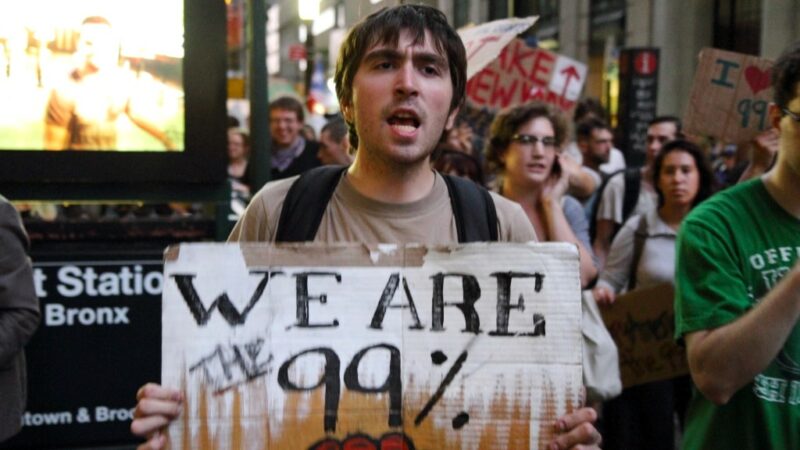 Dark clouds over the new Maastricht “Gouvernement” on the Meuse: the Maastricht Treaty, which launched the European Monetary Union, was signed here on February 7, 1992. (Picture: Julian Ilcheff Borissoff, Wikimedia Commons)
Dark clouds over the new Maastricht “Gouvernement” on the Meuse: the Maastricht Treaty, which launched the European Monetary Union, was signed here on February 7, 1992. (Picture: Julian Ilcheff Borissoff, Wikimedia Commons)
At first it seemed as if the new President of the European Central Bank (ECB), Christine Lagarde, would simply continue the loose monetary policy of her predecessor Mario Draghi. But Lagarde’s first statements prove that she does not want to maintain the status quo of zero interest rates and bond purchases, but also wants to “be there” in the fight against global warming. This heralds a green shift in the monetary policy of the ECB. A look at the history of the European currency project to date makes this new focus more understandable in some ways, even if it is no more correct. An eco-conscious monetary policy will not solve the real problems of the euro zone, and if we take a closer look, we see it will even exacerbate these problems.
This is an abridged version of this article. The full and well-documented version—only in German—can be downloaded here as Austrian Institute Paper No 28/2020: Download PDF
To begin, the European Central Bank’s new policy may very well explain how European Union Commission President Ursula van der Leyen will finance her €1 trillion “Green Deal,” the goal of which is to make Europe a carbon-neutral economic area by 2050. Through the printing press. After becoming the lender of last resort in the wake of the 2008 financial crisis and helping ailing banks and nations, the ECB would also, with a green monetary policy, become an economic government that prints its own budget. In concrete terms, this means that in order to protect the climate, the EU would take on debts and loans. But since it is not allowed to do so, it is shifting the debt (and this would not be the first time) to the intergovernmental level, i.e. to the EU’s rescue and investment funds. The ECB would then participate in the financing and buy the bonds of entities that the EU Commission classifies as particularly climate-friendly.
This could soon lead to the next transformation of the ECB. Since there is no guarantee that companies will actually use the loans granted to them by the ECB for environmental and climate protection, the ECB would have to review it. Thus, the ECB would also become a climate and environmental protection agency—a function not exactly envisaged at the Central Bank’s founding.
A Risky Project That Is Reminiscent of the 1930’s
Admittedly, such plans are likely to be guided less by concern about the climate than by fiscal policy considerations. The popular fight against climate change could be the optimal strategy for central banks to directly finance states after the policy of cheap money failed to solve the problems resulting from the financial crisis. This is where the ideas of “Modern Monetary Theory” come into play, which, if you take a closer look, is certainly not as novel as it claims to be. The German economist Daniel Stelter, for example, recalls central bank-financed economic stimulus programs in Japan, Nazi Germany, and the U.S., designed to tackle the Great Depression. At that time, existing assets— machinery, plant, and equipment—were devalued through rapid investment in better technologies, thus creating the basis for new demand, which was financed by government stimulus programs and an expansion of the money supply. Similarly, the fight against climate change, by moving away from fossil fuels and penalizing CO2 emissions, should now lead to the devaluation of the existing assets of the many companies and private individuals that produce CO2. According to Stelter, this will lead to a compulsion to make new investments, which the state will finance through a trillion-euro subsidy program: “Charging stations instead of gas stations, electric cars instead of combustion engines, heat pumps and solar instead of oil heating ….” This cannot be financed without central banks.
These plans are certainly very risky. Daniel Stelter, for example, criticizes the planned economy orientation of this green monetary policy, which obviously follows the poor example set by Germany in recent years. Growing deindustrialization in Germany and, at the end of December, the biggest economic slump since the financial crisis are being felt in vehicle production and manufacturing, in stark contrast to the rest of the EU.
There is no mention in the Maastricht Treaty of a targeted channeling of resources to specific sectors of the European economy.
Furthermore, the plans of the EU Commission do not take the consumer into account. If the highly complicated changeover to electric cars bypasses the real needs of consumers, it will hardly be profitable and will have to be financed by the taxpayer in the future—not only through taxes, but also through monetary policy. Moreover, citizens can hardly influence such measures, either as consumers or voters. After all, governments are actually responsible for the targeted promotion of specific sectors of the economy. If the ECB takes over these agendas, they could no longer be legitimized by governments via parliaments.
With this new turn of events, the ECB is also committing another breach of the rules: the Maastricht Treaty does not mention the targeted channeling of resources to specific sectors of the European economy. However, no one can guarantee that climate policy will remain the same. Today, the ECB is committed to environmental and climate protection; tomorrow it may just as well be something else. In this way, climate policy becomes the gateway for state-controlled planned economies. In principle, nothing stands in the way of extending it to other areas.
Furthermore, with this policy the ECB is punishing CO2 sinners at the expense of other market participants. Not to be forgotten are also the redistributive effects of money creation due to the Cantillon effect, which are ignored by Modern Monetary Theory. New conflicts can also break out between states in the face of differing interests and differing ideas regarding the design of climate-neutral policies: consider the case of nuclear power. Thus, the euro would continue to be a bone of contention in Europe.
The Prophetic Warning Cries of the Euro Critics
This ecological monetary policy also fails to address the real causes of the euro crisis. These are rooted, on the one hand, in the structural deficiencies of monetary union and, on the other, in the monetary policy practiced since the 1980’s. It is no wonder that policymakers hardly ever deal with them openly: the practical consequences would be far-reaching and foundational. Nevertheless, an honest look back shows that one can learn if one only wants to.
In 1991, when the Maastricht Treaty initiated the creation of the Monetary Union, the then ARD correspondent Rolf-Dieter Krause remarked: “Not a single time did those responsible publicly reflect on the quality of the Treaty.” Indeed, all prophetic warnings were deliberately ignored, including those of former British Prime Minister Margaret Thatcher, who openly opposed the Maastricht Treaty and its ratification.
For example, Thatcher warned against rigid exchange rates and pointed to the massive differences between the European economies in terms of level of development, economic potential, tax policy, and inflation. Thatcher saw a threat in the rigidity of fixed exchange rates, which among other things lead to artificially cheap imports and artificially expensive exports, which prevent currency adjustments. Thatcher therefore anticipated massive economic upheavals, the resulting necessity of large money transfers between strong and weak economies, and increasing unemployment. In addition, the treaty lacked an “escape hatch.” All this was a breeding ground for new, extremist parties. The gradual emergence of a centralized European “Superstate” would lead to additional detachment of European institutions and alienation between citizens and political leaders.
Her words unfortunately proved far more clear-sighted than those of German Chancellor Helmut Kohl, who even in 2001 predicted that within five years Britain would join the monetary union, followed by Switzerland. It was precisely the rigid exchange rates brought into focus by Thatcher, of course, that were an incentive for the southern Mediterranean countries to adopt the euro. They were thus able to get rid of the fixed Deutschmark, which until then had exposed the highly inflationary policies of these states.
Immediately after the introduction of the euro, interest rates fell in the southern Mediterranean countries, especially on government bonds. This was due to falling inflation expectations—the transference of the Bundesbank’s reputation to the ECB was having an effect—and to the falling risk premium. Real savings, however, did not cover the low interest rates. As a result, numerous unprofitable real estate investments were initiated by loans in Spain and Italy. Ghost towns and empty airports are all that remain. Greece in particular lost competitiveness due to massively excessive wages. Since all euro countries—no matter how large or small—speak with only one voice in the ECB Governing Council, the southern Mediterranean countries did not need to fear the new currency despite their excesses.
When the crisis broke out in 2008, the EU lacked the provisions for dealing with state insolvencies and ailing commercial banks. As a result, the ECB tried to avoid state insolvencies by all means, and they did everything possible to keep all countries on the euro, which led to a steady stream of new rescue packages. In a free market economy, an over-indebted state like Italy would have to deal with its private investors. But the indebted euro nations are treating European partner countries like Germany as creditors. In view of such circumstances, one can no longer view the euro as a peacemaking project.
The Deutsche Bundesbank's TARGET2 claims currently amount to 900 billion euros. The claims can never be called in for payment by the Deutsche Bundesbank.
In the meantime, the former head of the Munich Ifo Institute, Hans-Werner Sinn, revealed Germany’s increasing susceptibility to blackmail due to the growing TARGET2 demands. Originally, the TARGET2 mechanism was intended as a payment transaction instrument. It is only since the euro crisis that the accounts no longer balance out, initially because German banks withdrew their money from the crisis countries. The TARGET2 claims of the Deutsche Bundesbank currently amount to 900 billion euros. But the claims can never be called in for payment by the Deutsche Bundesbank. Sinn speaks of interest-free and unlimited overdraft credits between the central banks. Germany has thus become the largest lender in the euro zone. If Italy, for example, leaves the euro zone, the Bundesbank and thus the German taxpayer will be left with the outstanding debts. This makes Germany increasingly susceptible to blackmail and makes further rescue packages even more likely.
What was also not considered: The European Economic and Monetary Union (EMU) lacks a deposit guarantee scheme. That is why the euro zone basically remains a cash union, because only the banknotes are equivalent in all euro countries. Bank deposits, on the other hand, vary according to the quality of the loans and, above all, the ability of the states to protect these deposits in the event of a bank failure. There is, of course, no political union for a uniform deposit guarantee system.
The Illusions of the “Third Way”
In addition to the design flaws of the euro, however, it is the loose monetary policy—which is not restricted to the euro area and can be traced back to the United States in the 1980’s—that is causing the euro area so much trouble today. Thomas Mayer, former chief economist at Deutsche Bank and founding director of the Flossbach branch of the Storch Research Institute, has been particularly concerned with this problem. He refers to the “Third Way” between capitalism and socialism promoted by Bill Clinton and Tony Blair. Its promise: security as under socialism, growth as under capitalism. And this may no longer be achieved through Keynesian “deficit spending,” but through a monetary policy that stabilizes the economy by pursuing an inflation target. Since then, to protect the economy against recessions, the central banks have been fighting every correction on the financial markets with lower interest. This favors indebted states and businesses, and credit becomes cheaper.
But the representatives of the “third way” thought that they could create macroeconomic stability through monetary policy while maintaining microeconomic flexibility. Their approach, however, was fundamentally mistaken.
Thus, a monetary union like that of the euro faces no small difficulties. After all, countries like Greece and Italy are heavily indebted. The representatives of the “third way” thought they could create macroeconomic stability through monetary policy while maintaining microeconomic flexibility. Their approach, however, was fundamentally mistaken. Monetary wealth is an elementary form of private ownership. When the state manipulates the value of money to achieve its own goals, it encroaches on the property rights of its citizens. Therefore, the targeted reduction of the value of money to achieve inflation targets is ultimately a stealth form of confiscation.
Moreover, if monetary policy protects economic agents from the consequences of their mistakes, then the market process becomes disabled. Confronting the unpleasant consequences of wrong decisions is part of the free market. The “third way” relieves individuals of responsibility for their actions, and the burden is ultimately borne by the general public.
One consequence of the “third way” is the artificial inflation of the financial sector, which now sets the tone for the real economy. The lowering of interest rates has also led to bubbles. When the credit bubble burst with the financial crisis of 2007/2008, however, no trend reversal followed. On the contrary: financial services continued to grow disproportionately and are still the largest sector of the U.S. economy.
The central banks can no longer find their way out of the policy of cheap money. The cheap money becomes the drug with which the central banks supply the financial markets. This hinders economic growth, which is why real wages and real incomes do not grow as much. At the same time, savings no longer earn interest. The ability of individuals in middle and lower income groups to provide for their old age by accumulating assets is increasingly disappearing. All the while, asset prices are rising, which is especially beneficial to older and wealthier people, while younger people are left without capital assets.
A Plan for Liberal Renewal
Thomas Mayer also makes proposals for reform away from green monetary policy. He demands a monetary order that serves the citizen. He considers it beneficial to have competition between state-issued money and privately issued money. New digital currencies would create good conditions for a future “multipolar monetary order” in which the best money prevails. And in order to salvage the euro, a euro bank deposit could be created that is 100-percent covered by ECB reserve money. To this end, the ECB would simply have to continue its bond purchase program and take over the repayment of expiring government loans and government bonds. The conversion from credit money to covered money could thus “be linked to a reduction in outstanding government debt.”
Together with the economists Justus Haucap and Stefan Kooths, and with the German FDP member of the Bundestag, Frank Schäffler, Thomas Mayer proposes a “confederal Europe”: “Many European citizens reject the goal of a European central state and oppose the transfer of national sovereignty to a European center without a credible regulatory design and without real democratic legitimacy.”
Margaret Thatcher already envisioned a “confederal” model of a Europe of nation-states 30 years ago. If she had her way, it would be “based on the idea of cooperation between independent sovereign countries loosely linked in a free trade area, with competition between different tax and regulatory systems and with freely floating currencies.”
As you can see: There are alternatives for those who want to learn from history.



